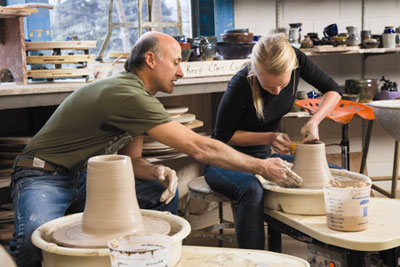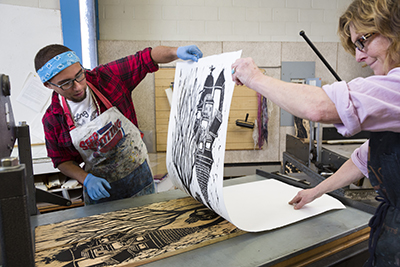
A Passion for the Arts — and for Life
by Asher Ellis '06
Photos by Bill Truslow
"Art is the most intense mode of individualism the world has known,” Irish writer Oscar Wilde once said, and a stroll through the Marian Graves Mugar Gallery at the Sawyer Fine Arts Center affirms his famous phrase. Showcasing the works of Colby-Sawyer faculty and students, the gallery walls offer glimpses of the world from each artist's point of view. These expressions of creativity leave no doubt that the fine arts provide a path for our faculty and student artists to discover and convey their individuality.
“I teach my students that they need to have a passion,” says Professor and Chair of Fine and Performing Arts and Joyce J. Kolligian Distinguished Professor Jon Keenan. “They need to follow their interests and be curious. There are different paths you can take and if you find your love or your interest in any field, whatever it may be, that's going to make your life more whole and fulfilling.”
A significant rise in art graduates in the U.S. in recent years suggests that growing numbers of students are finding their passion in the arts. In 2009 alone, more than 89,000 students in U.S. colleges and universities graduated with degrees in the visual and performing arts—more than in computer science, math and chemical engineering combined, and more than double the number of arts degrees earned in 1985.
Professor Keenan speculates that strong interest in the arts reflects the variety of skill sets that art education provides. “The arts touch all kinds of areas of study, so the rising number of art majors tells me that there's a need in our society for students who can creatively solve problems in our changing world. Even if they go into medicine, or law, or business, or education, having that foundation is fundamental.”
Associate Professor David Ernster agrees, especially in the context of his and Professor Keenan's shared medium. “In the field of ceramics, students learn a variety of skills. The chemistry of clay and glazes helps students to understand that, in ways not always apparent, the processes and materials are interrelated and dependent on each other. That concept is also important in other walks of life."
Other Colby-Sawyer art faculty members offer a different explanation. Assistant Professor Mary Mead, who teaches printmaking, believes these statistics don't necessarily represent conscious decisions. “I have a tendency to believe that art finds you, you don't find art. You can't help it.” Professor Mead's student, Will Shearer '14, seems to support his professor's conclusion.
“At first, I wasn't sure if being an art major was a good idea,” says Shearer. “But as time passed, I realized that being an artist was all I wanted. Why would I want to do something I didn't love? When push came to shove, being an art major was the only thing that made any sense.”
However an artist finds his or her way into the arts, Professor Mead concurs that the benefits are not limited to artistic endeavors. “Study after study suggests the sort of brain activity that turns one into a good problem solver is creativity,” she says.
Faith Bouchard '15, a Graphic Design major, attests to the value of her art courses outside of the classroom. “I took my first typography class this semester and not only is it necessary for design education, it taught me a lot about what I see every day, everywhere I go. I had never noticed the text on my shampoo bottle, the font on my chip bag, or the alignment of text in my science book before this class. I just took this meticulous art for granted.”
Assistant Professor Hilary Walrod, Bouchard's graphic design instructor, is not at all surprised by this sort of reflection. “Design in particular has a lot to offer socially in terms of how we perceive information,” she says. “Everything we interact with, in any form of media, is design.”
Professor Walrod provides a relevant example of this idea when she considers our nation's method of voting. “The professional association for design worked on ways to redesign ballots after the election debacle in 2000. So is design important to our country and our culture? I would say so.”
Still, there are those who would suggest that the U.S. is saturated with art degrees. In 2012, several economists and other columnists wrote articles with statements like, “Graduates in the arts, psychology and journalism are less likely to create the kinds of innovations that drive economic growth.” Even pop artist Andy Warhol once said, “An artist is somebody who produces things that people don't need to have.”
While some may seek to diminish the value of a liberal arts education, particularly in periods of economic uncertainty, the art faculty at Colby-Sawyer hold fast to their stance. “I'm not going to deny that it's a challenge to make a living in the arts, or as a writer, or a journalist,” says Keenan. “But if you're well-rounded and educated, in terms of history and literature and arts and science and humanities, you're going to be marketable.”
“I think we're at a point in time,” Walrod adds, “when the scale of our systems has gotten so large that we're reaching this turning point when people think economic growth is more important than cultural development. That seems really short-sighted.”
Professor Mead is of the same mind, emphasizing that the arts are an irreplaceable commodity not only to our nation, but to our world. “Art is what defines us as humans. If we don't have thoughtful, creative people thinking about color and form and shape and being sensitive to our environment, we lose what it is to be human.
”Fortunately, it's unlikely that will happen at Colby-Sawyer — not with students like Chelsea Bakos '15, who did not hesitate to pursue a career in the arts. “I could not think of another area I wanted to focus on. From high school classes I knew I could handle my work being criticized and could see that the more feedback I received, positive or negative, the more my work improved.”
Professor Walrod believes the ability to offer and accept criticism is one of the great strengths of an education in the arts. “Another skill that all art students have is giving and accepting feedback. That's something that builds throughout one's years in art and design classes, but by the end, I would hope that our students are fluent and comfortable with that sort of exchange.”

That practice seems to be at work in the art studios of Colby-Sawyer, as Michael Bacote '13, a Studio Art major with a concentration in Ceramics, demonstrates. “I have learned to be open-minded to all criticism of my work. It helps me to understand the things I need to improve.”
Whether Bacote and his fellow art students realize it, they are learning skills that transcend their creative endeavors. As Professor Walrod puts it, “[Feedback] is something you can offer in any other form; you can critique ideas and policies with the same skill set you use to critique artwork.”
As a case in point, it is interesting to listen as artists comment on the intellectual rewards of their creative pursuits, and note how rarely these benefits are exclusive to their craft. For example, Professor Ernster says his work “requires close observation at all stages to foresee the results one wishes, and to learn what is practical and possible to achieve.”
Without previous knowledge of his field of study, one might conclude the professor was offering advice to entrepreneurs who were starting their own business. “This kind of observation and feedback is a valuable tool in many fields, and not least is the necessity of developing one's own techniques and voice based on direct experience,” Ernster maintains. It should come as no surprise, though, that he adds, “Since I have been here several graduates have gone on to run their own art businesses.”
And Ernster will likely see more students pursue entrepeneurship in the future. With a college degree in hand within months, Bacote plans to apply his artistic skills, and his broad-based education in the liberal arts, to a business setting. “I would like to be able to produce my work and have a coffee shop where I can sell my cups and bowls and serve others in any way I can. I want to share what I have learned and grow, and make the best of every opportunity.”
Graduates of the Fine and Performing Arts programs also bring their creativity and versatility to their plans for the future. By combining their knowledge and skills in the arts with other disciplines that they are exposed to through their liberal arts education, students like Bouchard graduate as multifaceted assets to the workplace.
“My minor in psychology will be great for the psychological aspect of advertising,” says Bouchard. “Another option I am looking into is art therapy. With that I could still enjoy my love of the arts, but also help people by incorporating psychology.”
Art therapy, says Keenan, is a field worthy of consideration. “We have a growing elderly population in the United States, so we need opportunities for [senior citizens] to create and express themselves. This is a very healthy way to engage yourself both therapeutically and expressively.”

Upon graduation, Shearer also plans to make a difference in the world by employing the expertise he has gained as an art student. “I would like to teach inner-city kids how to make prints. Over the summer I interned at the Center for Contemporary Printmaking (Norwalk, Conn.) and found it very rewarding. By applying what I learned from Colby-Sawyer, I was able to help others.”
With their vision and hard work, Bacote, Bakos, Bouchard, Rial, Shearer and the many other art students at Colby-Sawyer College will seek to make the world a more beautiful place to inhabit. No matter what occupations they decide to focus their creative minds on, Professor Mead reminds us of what she and other art faculty have discovered in their own lives as artists, and what they ultimately wish for their students.
“You try to impart to them that a life that is never idle is the most interesting life. Idleness is a scourge, and artists are never idle because we always have another drawing to make, another print to make. The images just keep coming.”
These students will benefit from a Colby-Sawyer education, whether they decide to dedicate their lives to the arts or sciences or something else entirely. Our life choices may be the most powerful way to communicate to the world who we really are. Yet there is no denying the intrinsic rewards of a creative life. Perhaps Robin Williams' character in the 1989 film “Dead Poets Society” said it best: “Medicine, law, business, engineering…these are noble pursuits and necessary to sustain life. But poetry, beauty, romance, love. These are what we stay alive for.”


